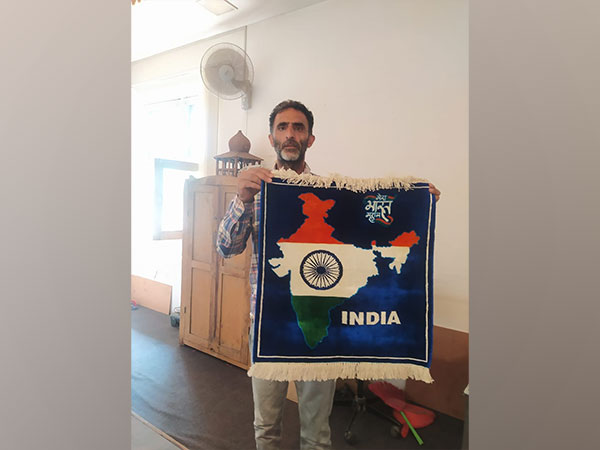Kashmiri craftsman’s silk carpet honors India’s map
Srinagar (Jammu and Kashmir) [India], August 17 (ANI): Artisan Maqbool Dar, who hails from Ashtengoo village in north Kashmir’s Bandipora district, weaves India’s map onto a silk carpet, igniting a symbol of artistry and preservation.

As a master of the age-old craft of carpet weaving, Maqbool had spent over three decades breathing life into intricate patterns and designs, but it was his latest creation that would set him apart.
The Covid-19 pandemic had cast a shadow of uncertainty over the lives of many, and the carpet industry of the Kashmir Valley was no exception. Maqbool’s carpet weaving unit, once bustling with the skilled hands of 40 women, now faced the bleak prospects brought on by the pandemic’s aftermath. Yet, amidst the challenges, his determination burned brighter than ever before.
One day, as he meticulously intertwined silk threads of vibrant hues, a novel idea took root in his mind. The image of India’s map, carefully woven into the fabric, began to take shape under his skilled hands. This was no ordinary map; it was a testament to his unwavering commitment to his craft, a symbol of resilience that he believed could breathe new life into the fading art and its artisans.
The idea grew wings, and with each passing day, his vision became clearer. As the last thread was woven, he held in his hands a stunning silk wall hanging bearing the intricate map of India. But this was just the beginning. Maqbool envisioned his creation adorning the historic Red Fort in New Delhi, a place where the eyes of the nation and the world would fall upon it. With a determined glint in his eyes, he spoke, “I want this carpet to be put up at Red Fort in New Delhi. I wish to put it up myself. It will be visible to everyone from there, and people will notice the Kashmiri craft, which would help us artisans,” he said.
But his innovation didn’t stop there. Alongside the map, he had woven a tricolour masterpiece, a testament to his patriotism and his belief in the power of his art to evoke change. “The main idea is to bring the attention of the government towards the arts and artisans. I also made tringa because I really wanted to; every office, including PM Modi and all top officials, has an Indian flag in the office, and that’s how I got the idea,” Maqbool explained.
With his creation in hand and hope in his heart, Maqbool set out on a journey beyond the serene confines of Ashtengoo Village. His story reached the ears of many, capturing the imagination of a nation that marvelled at his dedication and artistry. News of the silk wall hanging with the map of India and the vibrant tricolour spread like wildfire, resonating with people who recognised the urgency of preserving traditional crafts.
Through it all, his carpet weaving unit remained a sanctuary of creativity and hard work, where 40 women found not only employment but also empowerment. “I always wanted to help the women so that they could support themselves. Around 40 girls are working with us, and I hope the government supports us; otherwise, it’s very difficult for us to survive. The craft is dying, and if we are not helped, then we will lose this art and craft,” Maqbool said with a hint of concern for the future.
As Maqbool’s story continued to spread, his dream of showcasing the Indian map on a silk wall hanging at the Red Fort gained momentum. People from all walks of life rallied behind him, joining his cause and advocating for the recognition and support that artisans like him so rightfully deserved. The power of his art, combined with his determination, ignited a spark of change that could breathe new life into the dying craft.






